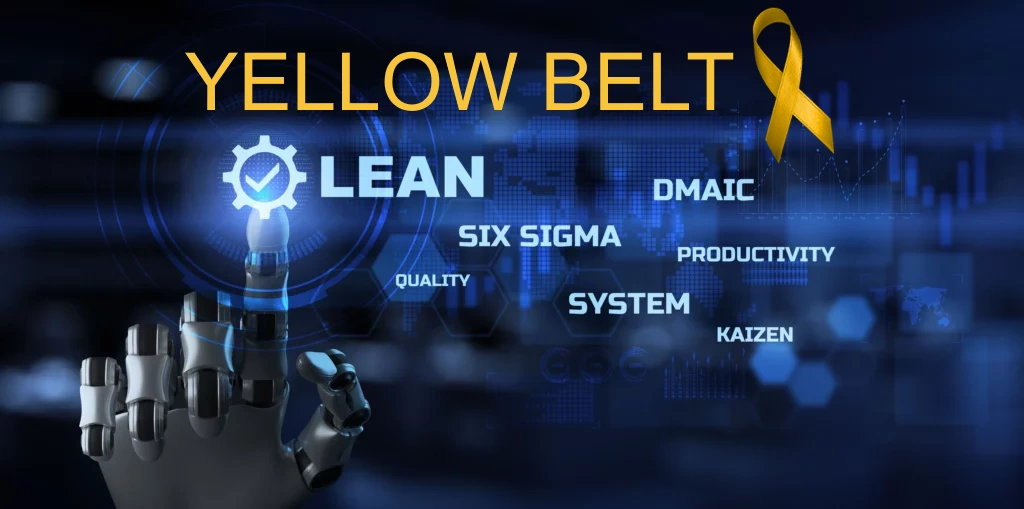Lean Six Sigma Yellow Belt
Current Status
Price
Get Started
Program Description
The Lean Six Sigma Yellow Belt program allows Executives and Managers to understand and support Lean Six Sigma initiatives in an organization dedicated to continuous improvement.
Lean Six Sigma combines two of the most powerful improvement methodologies in modern history – Six Sigma and Lean. This course is designed for business professionals looking to enhance their value to organizations that need to optimize critical business processes and enhance a culture of continuous improvement
Who should take this course?
WGA’s Lean Six Sigma Yellow Belt Certification course is designed for individuals seeking to become certified Lean Six Sigma Yellow Belt practitioners, Product Owners, Project/Program Managers, and/or Team Members. However, any organization or anyone within an organization looking to become more effective in development and delivery of its products and services can gain valuable knowledge and insight by taking this course. With completion of the course, participants will be prepared to help move your organization forward using Lean Six Sigma principles.
2-Day Lean Six Sigma Yellow Belt Certification Course Curriculum
- Introduction to Lean Six Sigma (What is Lean Six Sigma?)
- Customers (Internal and External)
- Lean Overview: What is Lean?
- Lean Definition
- Results Achieved with Lean Six Sigma
- The Deming Cycle/Wheel: P.D.C.A.
- What is Six Sigma? (1.5 Sigma Shift)
- Statistical Objective: Reduced Variation/Defects
- Six Sigma Behaviors/Six Sigma Summary
- Lean and Six Sigma
- Six Sigma Focus & Approach – Transfer Function: Y=f(X)
- Brief History of Lean
- The Five Principles of Lean
- Consensus Criteria Prioritization Matrix
- Weighted Prioritization Matrix
- 2×2 (4-Block) Consensus Prioritization Matrix Impact vs. Effort and Cost vs. Value
- Lean Six Sigma Project Selection
- Class Project Charter Development
- Common Wastes (TIMWOODS)
- What is a Process?
- Summary of Mapping Choices: Where/ When to Use
- Process Mapping / SIPOC
- Process Flow Maps/ Swim Lane
- Spaghetti Chart
- Value Stream Mapping
- Release Planning
- Sprint Planning
- Select a class project- new app idea
- Review: What is Value?
- Business Process Management
- Balanced Scorecard
- Using Metrics
- Owners & Stakeholders
- Metrics Summary
- Cost of Quality/Cost of Poor Quality
- What is the Cost of Poor Quality (COPQ)?
- Cost of Quality Optimization
- Financial Cost of Quality – Reporting
- Design for Six Sigma (DFSS) (1-10-100 Rule, DFSS Roadmaps)
- Quality Function Deployment (QFD) (House of Quality)
- Failure Mode and Effects Analysis (FMEA)
- Kaizen – “Change for the Better” or “Improvement”
- 5S
- Visual Management
- Standard Work
- TAKT Time
- Pig Exercise (External File)
- Processes and Quality Defects (Poke Yoke)
- Continuous Flow
- Kanban
- Theory of Constraints
- Projects and Teams: Stakeholder Analysis
- Gantt Charts
- Project Risk Analysis and Project Closure
- 7 Management & Planning Tools
- Team Dynamics & Performance
- RACI (Responsible, Accountable, Consulted, Informed)
- PDCA, DMAIC and other Continuous Improvement Processes
- The DMAIC Process
- Define Phase
- Deliverables of the Define Phase
- Define Phase Activities
- Who are our Customers?, Identify Customers, Analyze Customer Data
- Gathering Custom VOC/Data, Customer Needs. Critical-to-Quality (CTQ), Translating VOCs to Metrics
- Establish Project Metrics
- Defects per Unit: DPU
- DPMO: Defects per Million Opportunities
- Rolled Throughput Yield (RTY), RTY Exercise
- Value Stream / Value Chains
- Customer Expectations, The KANO Satisfaction Model
- Define Phase Action Items, Roadblocks
- Define Phase Summary
- Measure Phase
- Measure: Purpose and Deliverables, Process Analysis, Process Mapping
- Collecting Data, Data Types, Data Collection, Sampling
- Define Performance Standards, Operational Definition
- Purpose of Basic Statistics
- Some Statistics (calculate: Mean, Median, Mode, Range)
- Parameters vs. Statistics
- Measures of Dispersion
- Graphical Methods: Pareto, Boxplots, Scatter Diagrams, Histograms, Normal Probability Plots
- Distributions: Normal, Binomial, Poisson
- Introduction to Measurement Systems Analysis or MSA
- Analyze Phase
- Deliverables of the Analyze Phase: Root Cause
- Other Common Root Cause Tools
- Fishbone/Ishikawa Diagrams
- 5-WHYs
- Multi-Vari Studies, Correlation and Regression
- Population/Sampling and Hypothesis Testing
- ANOVA (Analysis of Variance)
- Improve Phase
- Improve Phase Deliverables
- Design of Experiments (DOE)
- Failure Modes and Effects Analysis: Calculating Risk Priority Number (RPN)
- Improvement Considerations and some Lean Tools
- Control Phase
- Control Phase Deliverables
- Statistical Process Control (SPC), Control Charts
- Process Capability (Cp, Pp, Cpk, Ppk)
- Control Plans
- PDCA, DMAIC and other Continuous Improvement Processes
- Review of Objectives
- A Lean Problem-Solving Process

